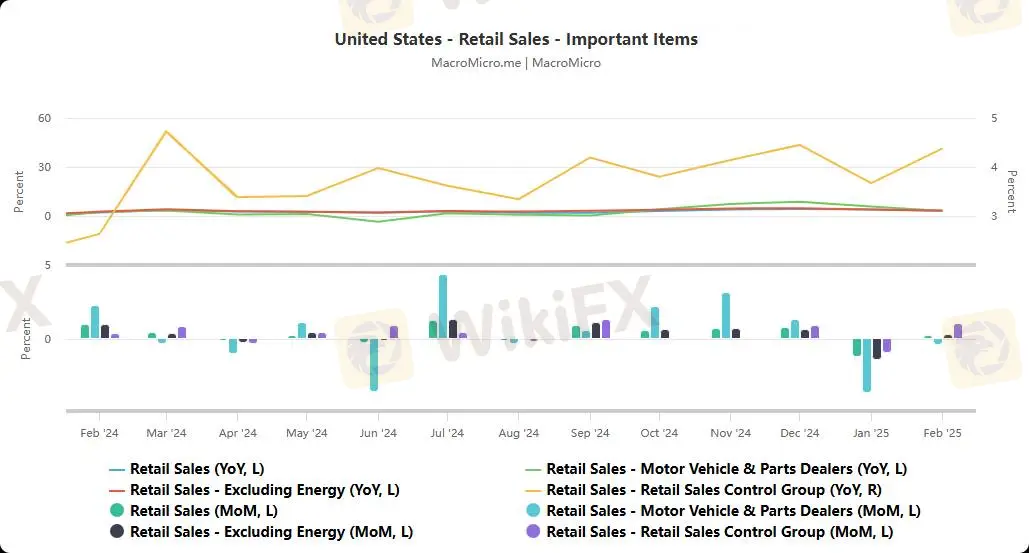简体中文
繁體中文
English
Pусский
日本語
ภาษาไทย
Tiếng Việt
Bahasa Indonesia
Español
हिन्दी
Filippiiniläinen
Français
Deutsch
Português
Türkçe
한국어
العربية
【MACRO Alert】 Trump's tariff policy triggers market turmoil: weak dollar, soaring gold prices and un
Abstract: US President Trump recently signed an order to investigate tariffs on key minerals, marking a further escalation of his trade war strategy. This move not only triggered a chain reaction in
US President Trump recently signed an order to investigate tariffs on key minerals, marking a further escalation of his trade war strategy. This move not only triggered a chain reaction in the global economy, but also exacerbated the decoupling of the traditional relationship between the US dollar and US Treasury yields, while driving a historic rise in gold prices.
Trump's tariff policy expansion
The Trump administration has launched an investigation into imports of critical minerals in accordance with Section 232 of the Trade Expansion Act of 1962. These minerals, including rare earth elements, uranium, and processed minerals, are considered the cornerstone of the U.S. defense industry and are widely used in jet engines, missile guidance systems, advanced computers, radar equipment, and other fields. The results of the investigation will be submitted within 270 days. If it is found that imported minerals threaten national security, the president has the right to decide to impose tariffs.
The order is another move by Trump following tariffs on steel, aluminum, auto parts and semiconductors. At the same time, the US government also announced an investigation into drug imports and plans to support domestic mineral processing capabilities through financing and loans to reduce dependence on foreign imports. Although Trump tried to protect US manufacturing and energy production through tariffs, the market reacted strongly to this, with investors worried that it could disrupt international supply chains and push up consumer costs.
Divergence between the US dollar and US bond yields
Under the impact of Trump's tariff policy, the traditional relationship between the dollar and U.S. Treasury yields has shown its weakest performance in three years. Normally, rising U.S. Treasury yields will support the dollar, but the dollar has fallen rapidly recently, reflecting investors' doubts about the dollar's safe-haven status.
The Bloomberg Dollar Spot Index posted its biggest drop since November 2022 last week as traders bet on further dollar weakness. Options markets show investors expect the dollar to remain weak in the coming months. Meanwhile, the dollar has not benefited from long-term U.S. Treasury yields trading near 17-month highs, a decoupling that suggests confidence in the greenback is waning.
Analysts point out that investors are accelerating their withdrawal from US dollar assets, fearing that Trump's trade war may push the global economy into recession. The weakness of the dollar not only weakens its status as the world's reserve currency, but also exacerbates market concerns about the outlook for the U.S. economy.
Historic rise in gold prices
Against the backdrop of a weak dollar and global economic uncertainty, gold's appeal as a safe-haven asset has significantly increased. In the Asian session on Wednesday, the spot gold price broke through the four major thresholds of 3260, 3270, 3280 and 3290 US dollars per ounce, setting a historical high.
Since 2025, the price of gold has risen by more than 23% and has repeatedly hit record highs. Wall Street giants such as Goldman Sachs and UBS have raised their gold price expectations, predicting that the price of gold will reach $3,700 per ounce by the end of the year and $4,000 per ounce by mid-2026. UBS strategists pointed out that with the changes in the global trade and geopolitical landscape, the demand for gold will continue to be strong, especially in the central banks, asset management companies and private wealth sectors.
The weakness of the U.S. dollar and the Federal Reserve's possible rate cuts provided further support for gold. The market expects the Fed to cut its policy rate by 100 basis points this year, which will reduce the opportunity cost of holding gold and attract more funds to flow into gold ETFs.
Summary and OutlookTrump's tariff policy has not only exacerbated global economic uncertainty, but also had a profound impact on the dollar and gold markets. The weakness of the dollar reflects market concerns about the US economy and policies, while the surge in gold highlights its importance as a safe-haven asset.
In the future, as the Trump administration continues to push forward its tariff policy, the market may face greater volatility. Investors need to pay close attention to the dynamic relationship between the US dollar, US bond yields and gold, as well as changes in the global economic landscape, to cope with potential risks and opportunities.
Disclaimer:
The views in this article only represent the author's personal views, and do not constitute investment advice on this platform. This platform does not guarantee the accuracy, completeness and timeliness of the information in the article, and will not be liable for any loss caused by the use of or reliance on the information in the article.
WikiFX Broker
Latest News
SkyLine Guide 2025 Malaysia: 100 Esteemed Judges Successfully Assembled
Vantage Markets Review 2025: Trusted Forex and CFD Trading Since 2009
TradingPRO: A Closer Look at Its Licences
The world could be facing another ‘China shock,’ but it comes with a silver-lining
A Guide to Intraday Forex Trading You Can't Miss Out
CONSOB Blocks Access to 13 Unauthorized Investment Websites
Why STARTRADER Is Popular Among Traders?
New SEBI Regulations on Intraday Trading
Everything You need to know about Barath Trade
OctaFX Flagged by Malaysian Authorities
Currency Calculator


